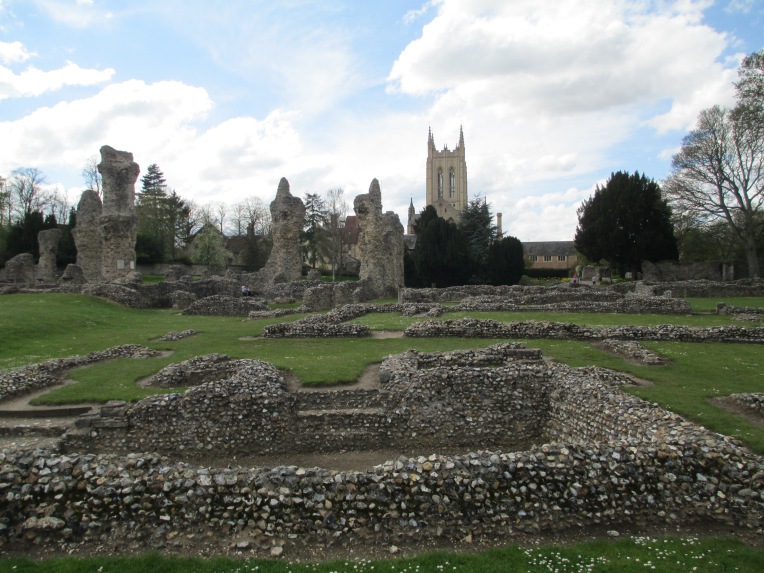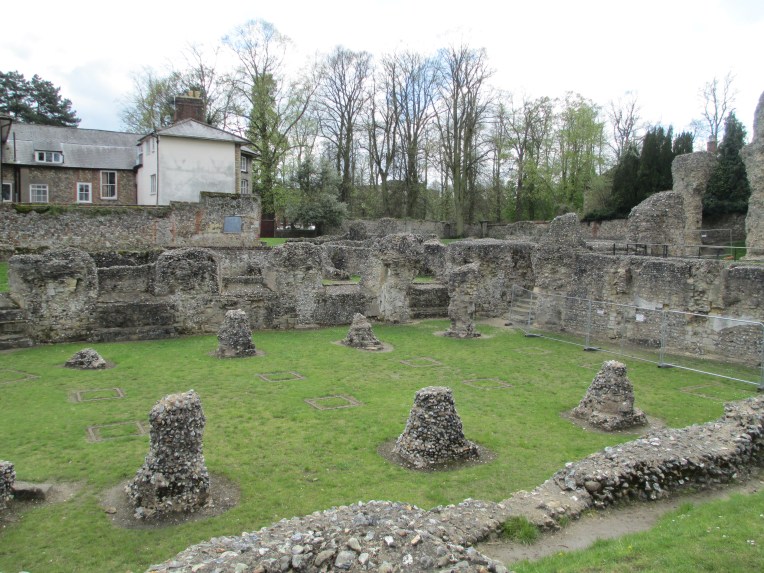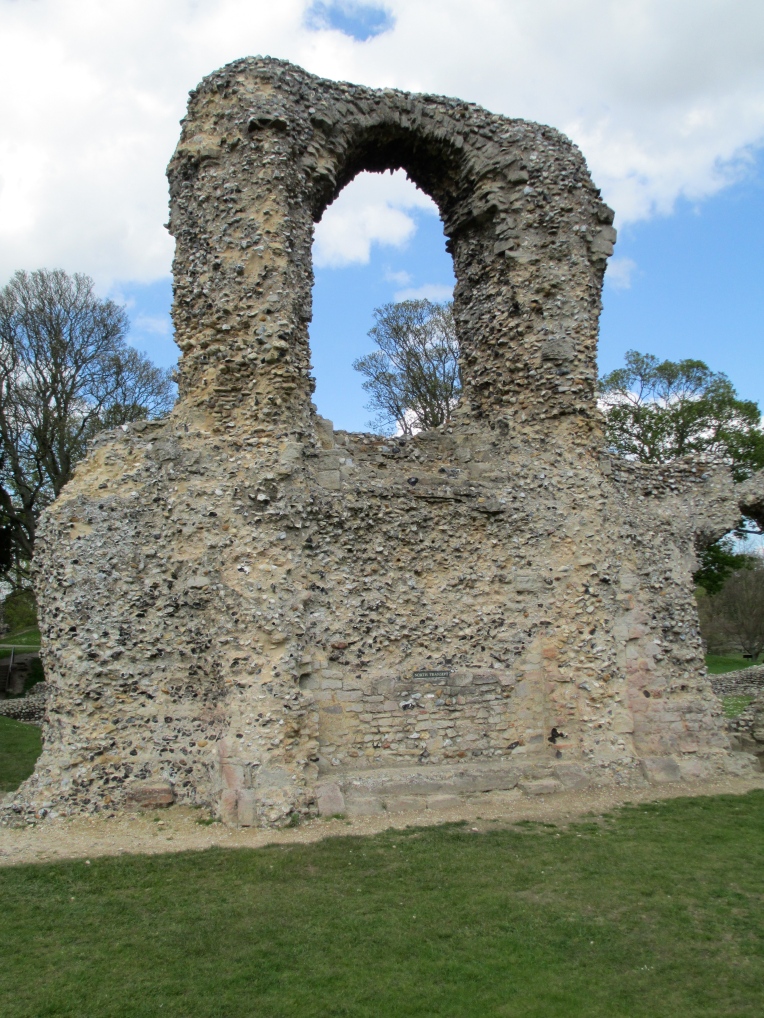The abbey at Bury St Edmunds is only ruins today, but it was once one of the largest and most powerful abbeys in England. It was home of the Chronicle of Bury St Edmund’s and was one of the places that the Magna Carta was planned. It was a casualty of the dissolution of the monasteries, handed over to the king in 1539.
There isn’t a lot left now, but what remains is majestic and poignant. It allows a glimpse of how spectacular the abbey would have been in all its glory.

The tallest pillar you can see to the left of the picture is near where the Magna Carta barons met to swear on the altar of St Edmund that they would obtain ratification of the Magna Carta from King John. The plaque below is affixed to it.

St Edmund’s is also the abbey that Eustace, the wildly unpopular son of King Stephen, plundered right before he died unexpectedly, possibly from choking to death. Many felt that his death was divine wrath, similar to the death of Henry the Young King.
The Chronicle of Bury St Edmunds was also written at the abbey. The Chronicle was written by Jocelin de Brakelond who was the chaplain of Abbot Samson. Samson was one of the Abbots who had the most structural influence on the abbey. Samson completed the great western front of the abbey. More of the west front survives today than any other part of the abbey, but it is largely houses. You can still see the remains of Samson’s great arches.

Samson also had an almost competition with Geoffrey Ridel who was Bishop of Ely. Geoffrey requested that Samson let him have oaks from Elmsett for his own building operations at Ely and Geoffrey had secretly gone through and marked the trees he wanted. Samson felt he had to agree, but he immediately felled the best oaks in Elmsett for his own works. This is an excellent illustration of the competition between the large religious institutions. You can see Ely Cathedral below.

Samson’s works on the abbey and general life at the abbey over this period , 1173-1202, are the main subjects of the Chronicle. It also provides an intriguing picture of Samson himself.
“ABBOT SAMSON was below the average height, almost bald; his face was neither round nor oblong ; his nose was prominent and his lips thick; his eyes were clear and his glance penetrating; his hearing was excellent; his eyebrows arched, and frequently shaved; and a little cold soon made him hoarse. On the day of his election he was forty seven, and had been a monk for seventeen years. In his ruddy beard there were a few grey hairs, and still fewer in his black and curling hair. But in the course of the first fourteen years after his election all his hair became white as snow.
He was an exceedingly temperate man ; he possessed great energy and a strong constitution, and was fond both of riding and walking, until old age prevailed upon him and moderated his ardour in these respects. When he heard the news of the capture of the cross and the fall of Jerusalem, he began to wear under garments made of horse hair, and a horse hair shirt, and gave up the use of flesh and meat. None the less, he willed that flesh should be placed before him as he sat at table, that the alms might be increased. He ate sweet milk, honey, and similar sweet things, far more readily than any other food.
He hated liars, drunkards, and talkative persons; for virtue ever loves itself and spurns that which is contrary to it. He blamed those who grumbled about their meat and drink, and especially monks who so grumbled, and personally kept to the same manners which he had observed when he was a cloistered monk. Moreover, he had this virtue in himself that he never desired to change the dish which was placed before him. When I was a novice, I wished to prove whether this was really true, and as I happened to serve in the refectory, I thought to place before him food which would have offended any other man, in a very dirty and broken dish. But when he saw this, he was as it were blind to it. Then, as there was some delay, I repented of what I had done, and straightway seized the dish, changed the food and dish for better, and carried it to him. He, however, was angry at the change, and disturbed.
He was an eloquent man, speaking both French and Latin, but rather careful of the good sense of that which he had to say than of the style of his words. He could read books written in English very well, and was wont to preach to the people in English, but in the dialect of Norfolk where he was born and bred. It was for this reason that he ordered a pulpit to be placed in the church, for the sake of those who heard him and for purposes of ornament.”
This excerpt offers an intriguing glimpse into the world of Bury St Edmund’s.
To read more go to http://www.fordham.edu/halsall/basis/jocelin.asp
The remains of St Edmund’s Abbey are like the bones of a giant, you can see the greatness that was once there. The first photo below shows the remains of what would once have been a beautiful window and the second shows that bases of pillars that held up part of the church.


One of the pieces that has survived the destruction of the abbey is the Norman Tower. It was built 1120-1148 and was designed to be both a gateway to the abbey church and a belfry for the church of St James next door, it still serves as a bell tower. It was funded by Abbot Anselm instead of a pilgrimage to St James De Compostella. The carved stone work that survives is truly beautiful.


Bury St Edmond’s was once one of England’s most important and majestic abbeys, you can see from the model below just how large it was, there might not be much left now but there are at least still echoes of the past.



 Bury St Edmunds is one of my favourite abbeys. It was the first abbey I ever saw and the ruins that remain are less romantically dishevelled than many of the other religious institutions you’ll see on this list. There is an epicness to the ruins which is hard to convey in photographs.
Bury St Edmunds is one of my favourite abbeys. It was the first abbey I ever saw and the ruins that remain are less romantically dishevelled than many of the other religious institutions you’ll see on this list. There is an epicness to the ruins which is hard to convey in photographs.









